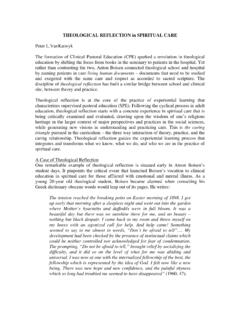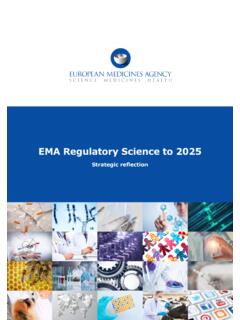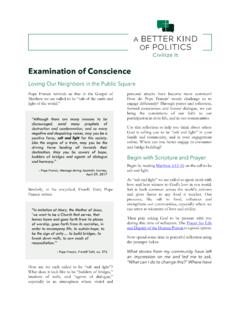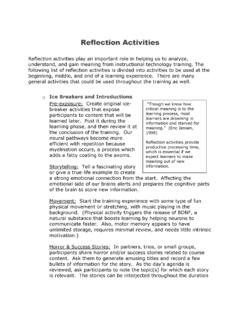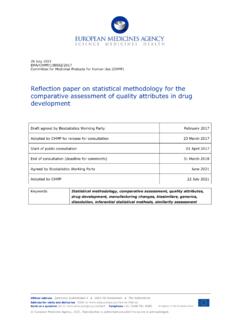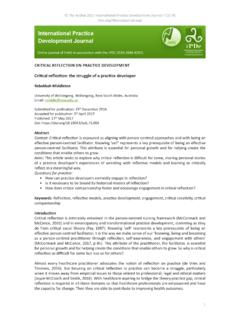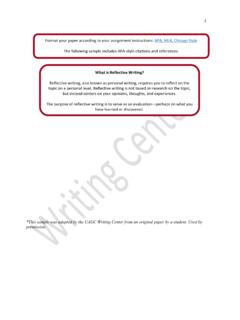Transcription of REFLECTIVE THINKING AND TEACHING PRACTICES: A …
1 International Journal of Instruction January 2012 , e-ISSN: 1308-1470 p-ISSN: 1694-609X REFLECTIVE THINKING AND TEACHING PRACTICES: A PRECURSOR FOR INCORPORATING CRITICAL THINKING INTO THE CLASSROOM? S. Chee Choy PhD., Tunku Abdul Rahman College, Malaysia Pou San Oo PhD., Tunku Abdul Rahman College, Malaysia The concept of REFLECTIVE THINKING as a precursor for incorporating critical THINKING has been not been adequately researched. Most research has not given any effective strategies on how to incorporate these two concepts.
2 There is a constant need to incorporate critical THINKING into the classroom without much success. This study will attempt to show a link between REFLECTIVE THINKING and its ability to stimulate critical THINKING . Teachers often perceive that critical THINKING skills need to be taught, however research has shown that they may not know how to do this effectively. The use of REFLECTIVE THINKING may be a precursor to stimulating critical THINKING in teachers. The research questions are on the REFLECTIVE THINKING skills of teachers and how they perceive themselves and their TEACHING .
3 In this study a total of 60 participants from institutions of higher learning volunteered to answer a questionnaire to determine the level at which they reflected on their TEACHING practices as an indicator of their level of critical THINKING . It was found that most of the teachers did not reflect deeply on their TEACHING practices. They did not seem to practice the four learning processes: assumption analysis, contextual awareness, imaginative speculation and REFLECTIVE scepticism which were indicative of reflection.
4 It would suggest that critical THINKING is practised minimally among teachers. Further research need to be carried out on how to bring about REFLECTIVE practices among teachers and how it would enhance the quality of lessons in terms of critical THINKING . Key Words: REFLECTIVE THINKING , critical THINKING , TEACHING practices, pedagogy, TEACHING , quality of lessons, teacher reflection 168 REFLECTIVE THINKING and TEACHING Practices .. International Journal of Instruction, January 2012 , INTRODUCTION There has been a concerted effort among universities and institutions of higher learning to incorporate critical THINKING into their curriculum.
5 However, as evidenced by researches (Choy & Cheah, 2009; Rudd, 2007; Black, 2005; Vaske, 2001), students may not be able to think critically because their teachers are not able to integrate critical THINKING sufficiently into their daily practice as it requires a certain amount of reflection. Added to this, critical THINKING is equated to higher order THINKING skills of Bloom s Taxonomy: analysis, synthesis and evaluation (Bloom, 1976) and teachers find difficulty incorporating these levels into their lessons (Choy & Cheah, 2009).
6 Therefore, this paper attempts to determine if teachers are practicing REFLECTIVE THINKING in their TEACHING . This is seen as a means to enhance critical THINKING . The study also attempts to determine how teachers perceive themselves and their TEACHING practices as this is also indicative of the amount of REFLECTIVE THINKING they do. REFLECTIVE THINKING (Dewey, 1933) is thought to enhance critical THINKING . It is part of the critical THINKING process specifically referring to the processes of analysing and making judgments about what has happened.
7 Learners who think reflectively become aware of and control their learning by actively accessing what they know, what they need to know and how they bridge that gap (Sezer, 2008). Therefore, critical THINKING involves a wide range of THINKING skills leading towards desirable outcomes and REFLECTIVE THINKING helps to integrate these THINKING skills by helping with judgments (Shermis, 1999). An important role of REFLECTIVE THINKING is to act as a means of prompting the thinker during problem solving situations because it provides an opportunity to step back and think of the best strategies to achieve goals (Rudd, 2007).
8 Therefore teachers who are able to use REFLECTIVE practices will themselves be more attuned to using this strategy to help students think critically (Shermis, 1999). Teacher REFLECTIVE THINKING Practices According to Boody (2008), teacher reflection can generally be characterized as: retrospection, problem-solving, critical analysis and putting thoughts into action. For this review, we have integrated the theoretical frameworks by Boody (2008), Hamilton (2005) and Schon (1987) and will discuss REFLECTIVE THINKING based on the following characteristics: a) reflection as retrospective analysis, b) reflection as problem solving, c) critical reflection of self, and d) reflection on beliefs about self and self-efficacy.
9 Each of these will be discussed in turn. Choy & Oo 169 International Journal of Instruction, January 2012 , Teacher reflection as retrospective analysis (ability to self-assess). This approach takes reflection as bending thoughts to incorporate prior experiences and how these experiences could influence the current practices of teachers. This retrospective analysis also includes the ability to self-assess. Teacher reflection as a problem solving process (awareness of how one learns) Teacher reflection can be thought of as taking necessary steps to analyse and articulate problems before taking action.
10 This allows for more constructive action to be taken rather than implementing a quick fix (Boody, 2008). The challenge is to be able to demonstrate in action what is taught in the classroom. Many teachers fail to connect between their TEACHING and what they are actually practicing and vice versa (Rudd, 2007). Critical reflection of self (developing continuous self improvement) According to Brookfield (1988), in order to be critically REFLECTIVE , there are four learning processes that can be engaged: assumption analysis, contextual awareness, imaginative speculation, and REFLECTIVE scepticism.










